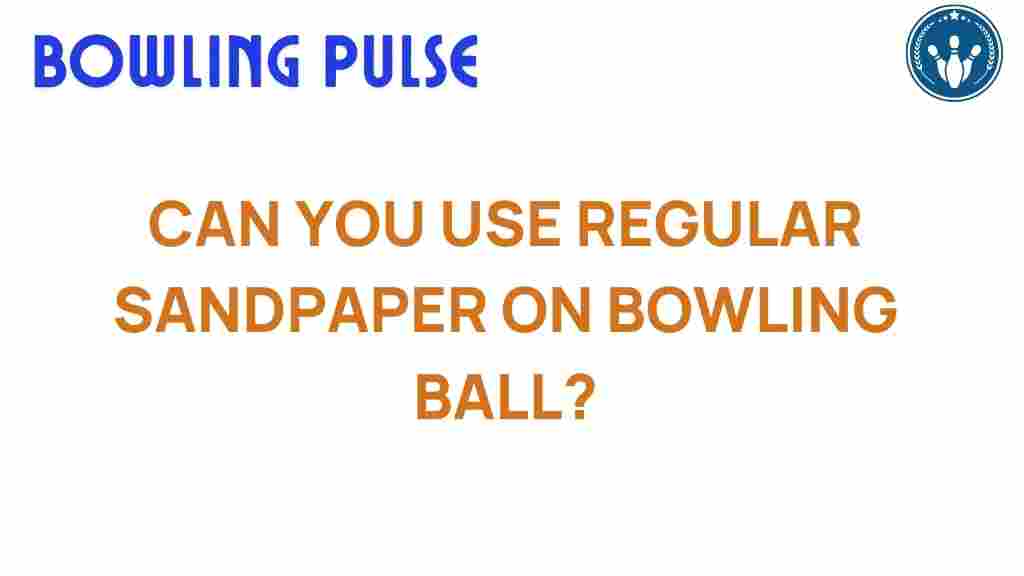Can Regular Sandpaper Transform Your Bowling Game?
When it comes to enhancing your performance on the bowling lane, many bowlers overlook the importance of equipment care. One essential aspect of maintaining your bowling ball is understanding the role that sandpaper can play in optimizing its surface texture. In this article, we will explore how regular sandpaper can transform your bowling game, providing you with valuable bowling tips to improve your skills and techniques. Whether you’re an amateur bowler or a seasoned player, understanding bowling ball maintenance can make a significant difference.
The Importance of Bowling Ball Maintenance
Bowling balls are designed to provide a specific reaction on the lane, which is heavily influenced by the ball’s surface texture. Over time, the surface of a bowling ball can become dull or damaged, leading to decreased performance. Regular bowling ball maintenance is crucial for maintaining that ideal surface and ensuring optimal performance.
- Improved grip on the lane
- Enhanced hook potential
- Better control and accuracy
- Increased consistency in your throws
Using sandpaper as part of your maintenance routine can help restore the ball’s surface, allowing it to grip the lane better and perform at its best. But how exactly can regular sandpaper be used in this process? Let’s break it down.
Step-by-Step Process for Using Sandpaper on Your Bowling Ball
Using sandpaper effectively requires some basic knowledge and care. Here’s a step-by-step guide to help you use sandpaper for your bowling ball maintenance:
1. Gather Your Supplies
Before you start, make sure you have the following:
- High-quality sandpaper (400 to 2000 grit)
- Microfiber cloths
- Bowling ball cleaner
- A flat, stable surface to work on
2. Clean Your Bowling Ball
Before applying sandpaper, it’s essential to clean your bowling ball. Use a suitable bowling ball cleaner and a microfiber cloth to remove any oil, dirt, or debris from the surface. This will ensure that the sandpaper can work effectively on a clean surface.
3. Choose the Right Grit Sandpaper
Different grits of sandpaper serve different purposes:
- Coarse Grit (400-600): This is ideal for removing scratches and smoothing out very dull surfaces.
- Medium Grit (800-1000): Suitable for general maintenance to keep the ball’s surface in good condition.
- Fine Grit (1200-2000): This is used for polishing the surface and achieving a slick finish.
Choose a grit based on the current condition of your bowling ball.
4. Sand the Surface
Gently sand the surface of your bowling ball in a consistent motion. Follow these tips:
- Use circular motions or back-and-forth strokes, depending on the area you are working on.
- Apply light pressure to avoid damaging the ball.
- Frequently check the surface to ensure you are achieving the desired texture.
5. Clean Again
After sanding, it’s crucial to clean the ball again to remove any dust or debris from sanding. Use your microfiber cloth and bowling ball cleaner to ensure a smooth finish.
6. Test Your Ball
Once you’ve completed the sanding and cleaning process, it’s time to test your bowling ball on the lane. Pay attention to how it reacts and make adjustments as necessary. Regular maintenance using sandpaper can significantly enhance your performance.
Troubleshooting Tips for Bowling Ball Maintenance
While using sandpaper can greatly improve your bowling ball’s performance, you may encounter some issues. Here are some common problems and how to troubleshoot them:
- Ball Hooks Too Much: If your ball is hooking excessively, consider using a finer grit sandpaper to smooth out the surface texture.
- Ball Doesn’t Hook Enough: Try using coarser grit sandpaper to increase the surface roughness, which can enhance grip on the lane.
- Uneven Surface: Ensure that you sand uniformly across the ball’s surface. Take your time and check often to avoid creating flat spots.
Bowling Tips for Enhanced Performance
In addition to using sandpaper for maintenance, here are some essential bowling tips to further enhance your game:
- Practice Regularly: Consistent practice is key to improving your bowling techniques.
- Focus on Your Grip: Ensure that you have a proper grip on the ball, as this can greatly affect your release and trajectory.
- Work on Your Approach: A smooth and controlled approach can significantly impact your performance.
- Adjust to Lane Conditions: Be aware of how different oil patterns affect your ball. Adjust your technique and equipment as necessary.
By integrating bowling ball maintenance with these tips, you can take your game to the next level.
Understanding Surface Texture and Performance Enhancement
The surface texture of your bowling ball is one of the most important factors influencing its performance. Smooth surfaces tend to slide more, while rougher textures provide more grip on the lane. Here’s how to adjust surface texture for performance enhancement:
- For a Smooth Finish: Use higher grit sandpaper (1200-2000) to polish and reduce friction, ideal for dry lane conditions.
- For a Rough Finish: Use lower grit sandpaper (400-600) to increase grip, suitable for heavy oil conditions.
Understanding when to adjust your bowling ball’s surface texture can be the difference between a good game and a great game.
Conclusion
In conclusion, regular maintenance of your bowling ball using sandpaper can significantly transform your bowling game. By restoring the ideal surface texture, you enhance your ball’s performance, allowing for improved grip, control, and accuracy. Remember that bowling ball maintenance is crucial and should be part of your routine as an amateur or advanced bowler.
Incorporate the tips provided in this article, and don’t hesitate to experiment with different grits of sandpaper to find what works best for your bowling style. With the right equipment care and techniques, you can elevate your game and enjoy bowling even more. For more tips on bowling techniques and equipment care, check out this helpful guide!
Are you ready to take your bowling game to the next level? Start with your equipment and see the difference it makes!
This article is in the category Equipment and created by BowlingPulse Team
